So earlier this month I bought a desktop computer from the year 2000 off ebay!
My interest in this sort of thing started to pick up when I began playing old ZZT games for https://twitch.tv/worldsofzzt" target="_blank">Worlds of ZZT livestreams. At the time, the best option for playing ZZT on a modern system was with DOSBox which doesn't play nicely with ZZT's input handler making things feel unresponsive in more frantic situations or when precise movement is needed.
At the time, my idea was that I would buy an old laptop which would have a much smaller footprint than a full sized desktop. I aimed for something I could put Windows 98 SE on and honestly wasn't too commited to the idea, until I stumbled across a Dell Latitude C400 for a measly $26 shipped! At that point it was an impulse buy, and the idea of having a retro system to play earlier Windows titles that don't cooperate too well on modern machines seemed like a good buy. I dubbed it Latias because it fit so nicely with the actual model name.
I wound up having to spend a little bit more on it, buying an extra 512 MB of memory, plus a cable to use the propriatary Dell external CD-ROM drive (and later on I bought a 3.5" floppy drive for it as well), and although it was a cool thing, it never really got used too much. I never found audio drivers that worked with MS-DOS, and wound up installing Windows 2000 on it so I could run VDMSound which made DOS gaming a lot more viable. I did wind up getting a bunch of games over the year at thrift stores, as well as bringing back my old PC game collection from my parents' house when I last visited them. Probably the most I used it was for a little bit to play through the original Unreal, but as much as that laptop would have been a dream machine to have for me when it was brand new, running Half-Life and Unreal at 20-40 FPS with quality reduced and the resolution turned down to 800x600 wasn't very satisfying.
So I wanted a desktop, but justifying it was a bigger challenge. I ended up scapping plans for ZZT streams on it since the colors were always washed out and it just looked a lot worse than streaming from DOSBox. I also decided that since one of the goals of writing about and streaming ZZT games was to discuss what it's like playing today, I'd be better off doing so the way 99% of people are going to play ZZT worlds, which is not on 20 year old hardware. (Plus eventually Zeta came out and now even DOSBox is an inferior way to play ZZT so problem solved.)
During the time I was hunting down any possible solutions to DOS gaming on Latias I stumbled across https://www.youtube.com/user/philscomputerlab" target="_blank">Phil's Computer Lab, a YouTube channel that I pretty much binged watching videos on building old computers and eventually branched out to some other channels once I exhausted the bulk of Phil's retro content. I'd stay up late just browsing ebay hoping to come across something that was "perfect", deliberately trying to not actually buy something and fall down the rabbit hole of owning a desktop significantly larger than my modern mini-ATX desktop.
I'd fill watch lists and at one point nearly bought another machine, but decided against it at the last minute. As time went on, my standards laxed because even thought it would be a purchase that was almost certainly going to be $100 minimum plus a good $50 to ship, I really wanted to get something! What made me finally bite the bullet was somebody linking a tweet of somebody with original ZZT disks in 5.25" format wanting to get them imaged. Last summer I wound up buying some mysterious 5.25" floppy off ebay labeled "ZZT's Labyrinth" and had it sent to a friend into retrocomputing who had a drive to find out what was on it and image it. Clearly I needed to start 2020 with an investment into a 5.25" floppy drive, and for that I'd need a computer to put it in. Perfect.
That's all it took for me to drop $151 buying a twenty year old Gateway: something to trick my brain into believing that it wasn't "wasteful" to do this.
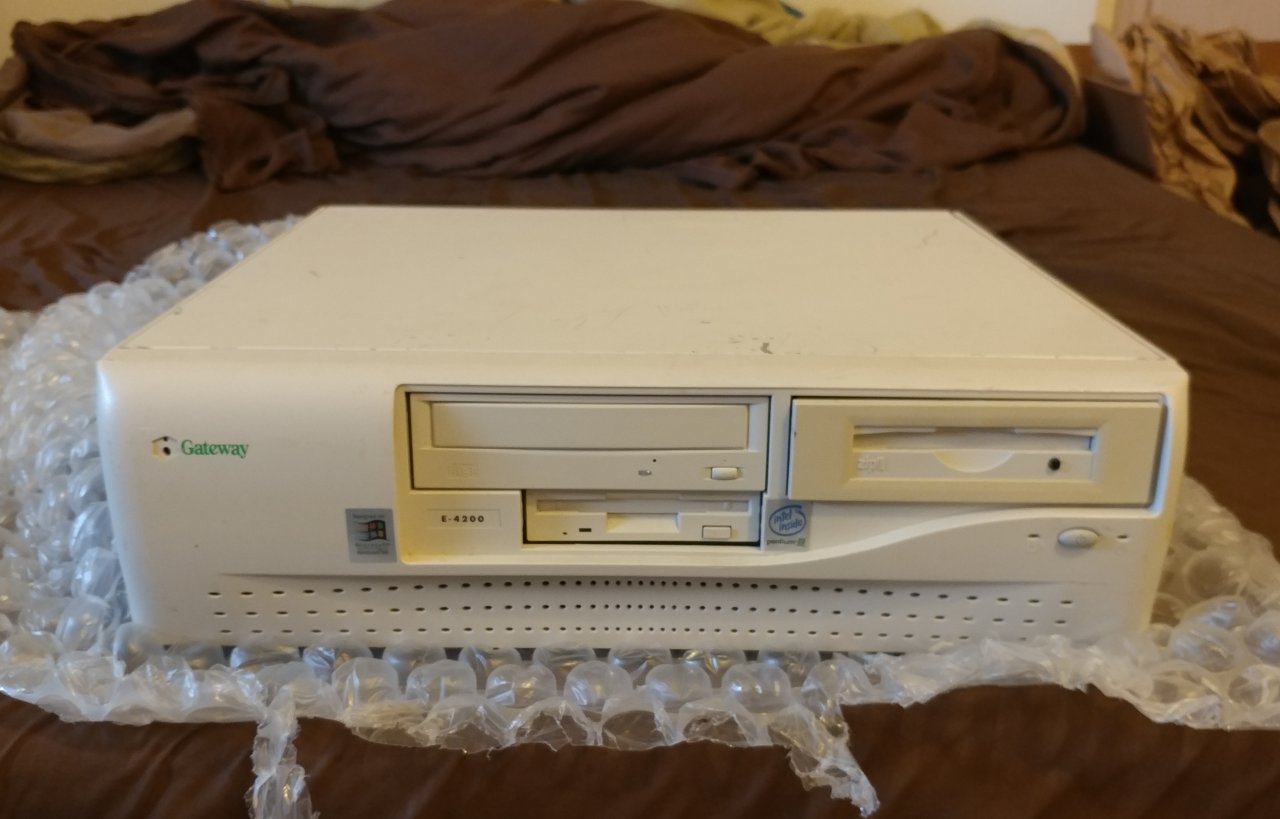
And here it is! I decided I wanted to continue the Pokemon naming theme. (In addition to the Dell Latias I bought a much needed new portable last year as well, a Microsoft Surface which is now a Microsoft Surskit.) Alas, the Gateway's modle is just "E-4200". If I was gonna stick to the theme the Gateway part was gonna have to change, and there aren't a lot of options there. Feraligatrway is a mouthful, so I decided on Raticateway.
The case was scratched up a bit, and my plan for the day it arrived was to take it apart and clean everything while watching AGDQ. Part of me wants to try painting the case (or something that won't make things worse for the wear) like I saw in an https://www.youtube.com/watch?v=J8qDk-MBkcg" target="_blank">LGR video (but boy do I not like that color he used). For the time being, it's going to be a beige box with some cosmetic damage.
It is also obviously a desktop form factor! I was going out of my way to find something like this. I think if you're going to get a 20 year old computer and work on it and turn it into something that's _you_, then you should make sure it looks how you like! I've always owned towers (if my current cube counts as a "tower"), but the horizontal layout has always appealed to me. The drives are right there, you just plop your monitor on top and fit two things in the same space.
I confess, the listing I bought wasn't the greatest as far as details went. I was told it had a 700 MHz Celeron, 192 MB of RAM, and no hard drive. The photos weren't the greatest so when I opened it up I was surprised to learn that the rightmost drive bay didn't have another floppy, but a zip drive! I was very jealous of my friend who got one of these and was able to keep all his files on a zip disk. (Bullet dodged.) Unfortunately I don't actually have any zip disks to play with it, so when I reassembled everything I didn't even bother attaching the cables to it. It's also the drive that I'll eventually replace with a 5.25" floppy drive which will have a bit more use beyond being a novelty.
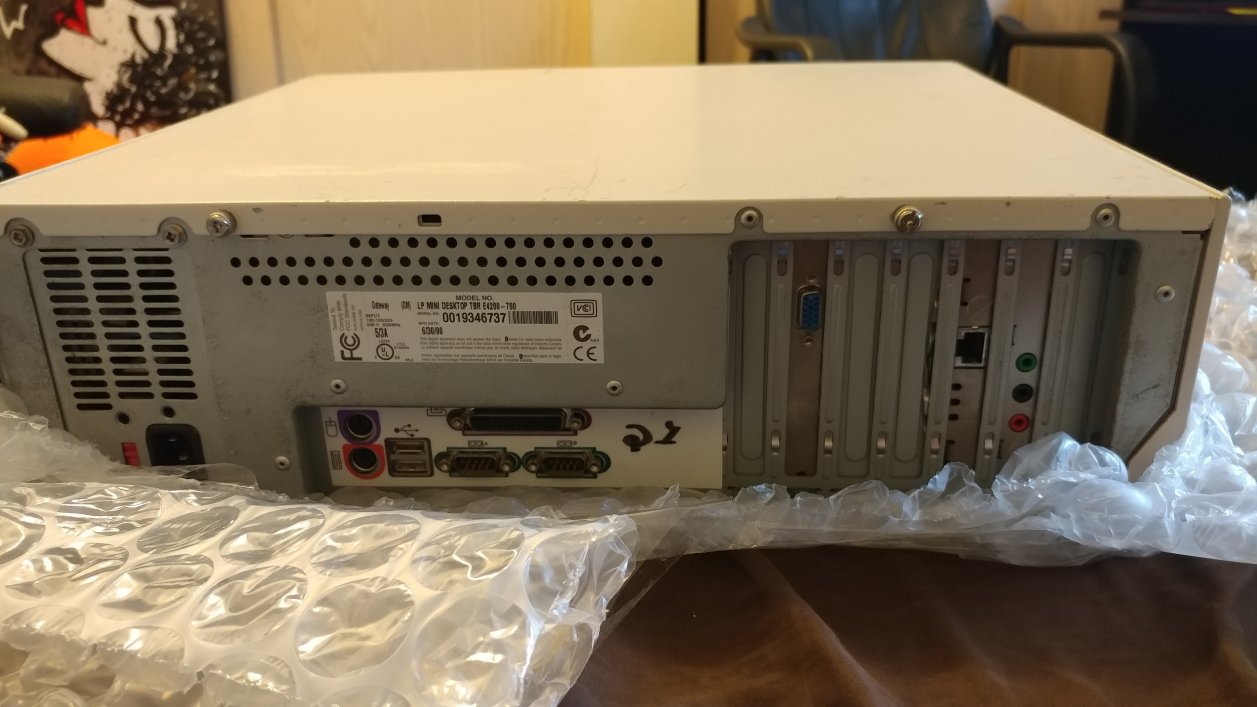
The back was more interesting. Gateway LP MINI DESKTOP TBR E4200-700 from June 2000. The motherboard is one old enough that it doesn't have any audio or video functionality on its own, so the ports are pretty minimal. Two USB ports which are of course 1.1, but damnit that's enough to use a spare keyboard/mouse/hub with an old 2 GB flash drive.
The listing did have an internal shot with the case opened, so I wasn't completely blind, but the specifics of what was inside were pretty unclear. All I could tell from it and the back of the case was PCI audio/ethernet cards and an AGP video card.
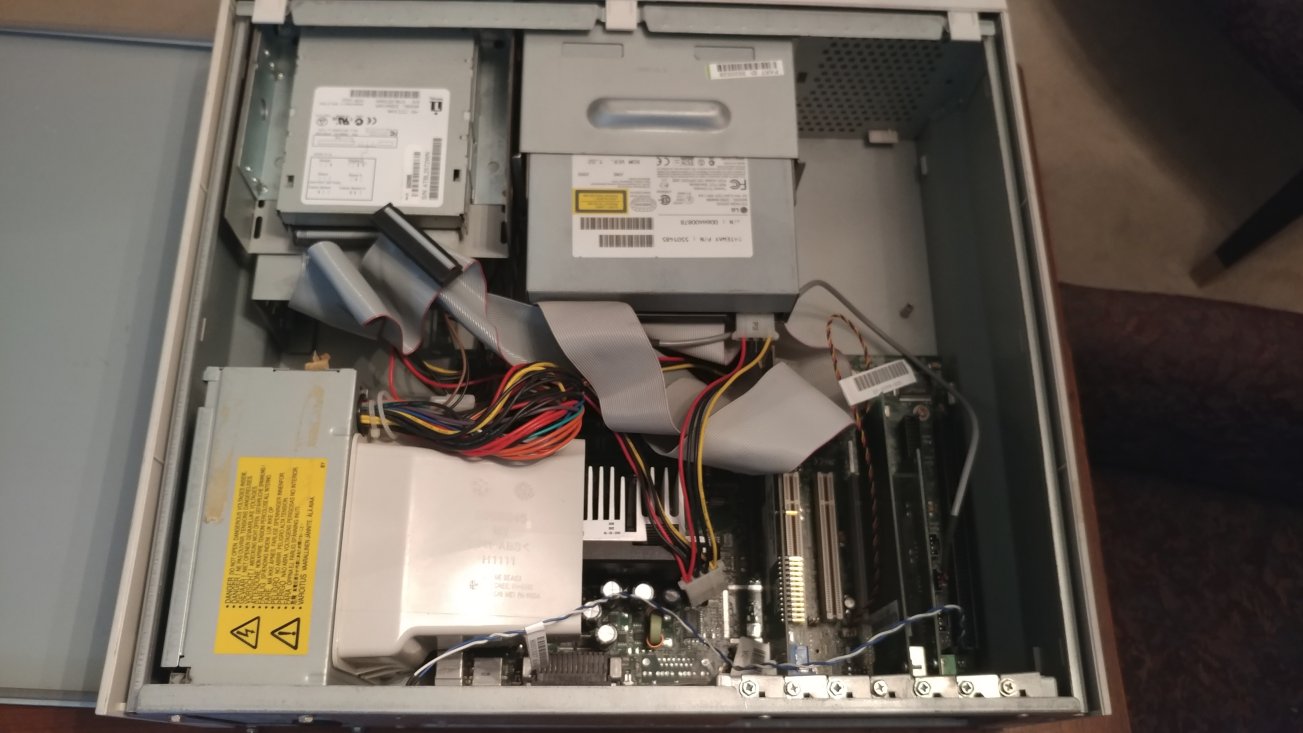
It was time to open the case, start identifying pieces, and stripping everything down for some cleaning.
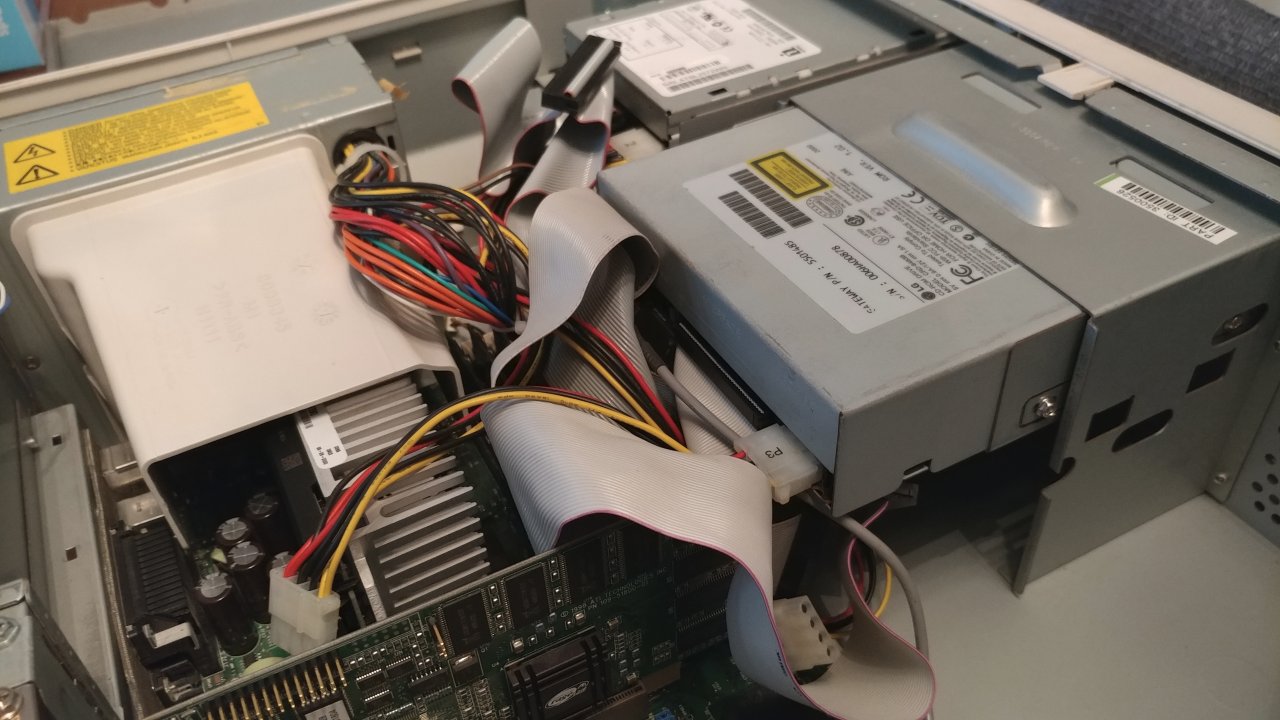
I won't pretend I'm an expert on cable management, but this is kind of just a blob. Though to be fair, my rebuilt computer doesn't have to finangle an extra IDE connection to the zip drive.
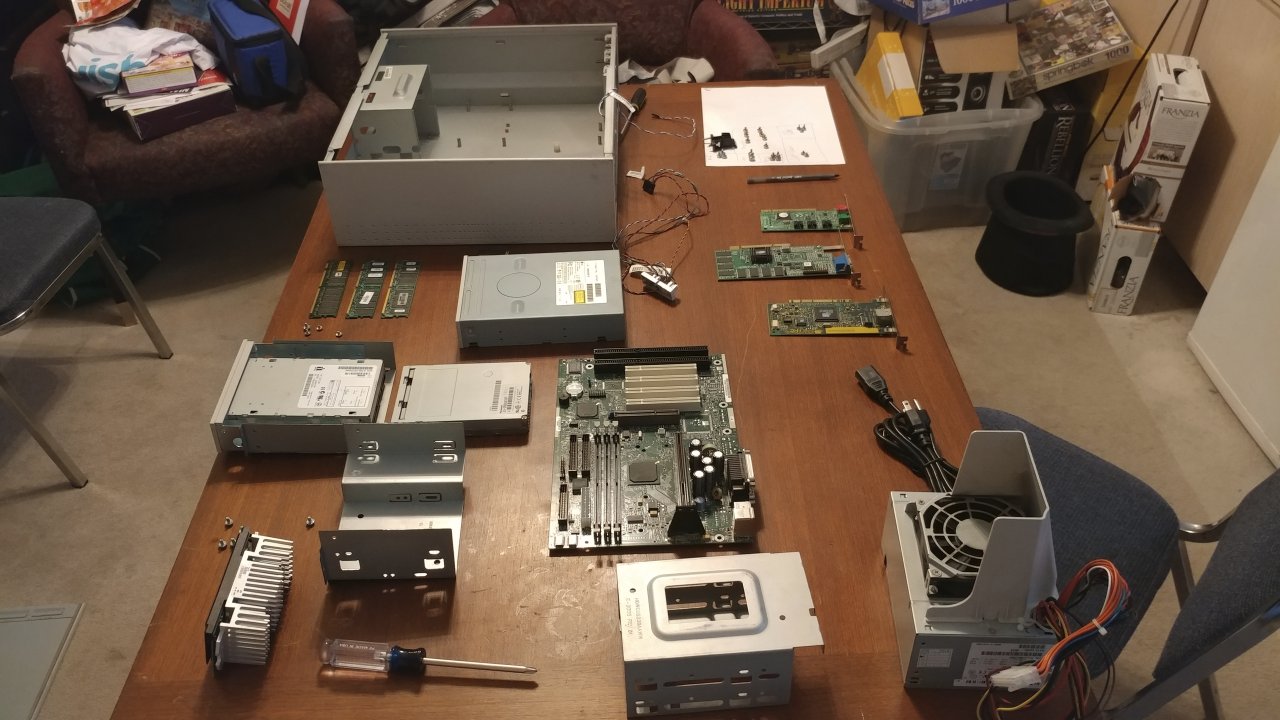
Jumping ahead, I managed to get everything removed. The screw situation was pretty bad with a lot of them being mismatched and clearly taken from other parts of the computer and just put in wherever. I tried to put it back together more consistently and had to break out a bag of spare screws from when I built my main desktop so I didn't have drives being held in place with a single screw.

When I was shopping around at first I was looking at Micro-ATX boards which just barely started happening in the Pentium 3 era, but they were few and far between, likely wouldn't save that much space, and it's very difficult to find one with both ISA and AGP. I do not want to turn into a YouTuber with 30 computers in a room so I decided to just focus on getting anything with ISA, PCI, and AGP to cover a wide range. This board should be comfortable running pretty much anything released in the 1990s plus a few years earlier and later as well.
Don't worry, the missing CPU bracket is attached to the CPU, it came right out with the processor itself. I mean, maybe worry about that.

One of the fun things about getting into this stuff 20 years after it was new is that I had never heard of a processor slot before. It's wild to me that there was this era where processors went from these tiny squarish things to these Super Famicom cartridges, and that within a year the cache was moved back onto the chip itself and it just went away. I love the idea of a processor that you can toss to somebody.
I was also looking at Socket 370 systems, but again ISA slots were getting rarer on them so I mostly focused on Slot 1. I do like how the slot does cover such a wide range of clock speeds though. This board can run a 233 MHz Pentium 2 through over a GHz with a P3 (and pushed even further if I pay a premium for a Socket 370 -> Slot 1 Sloket adapter).
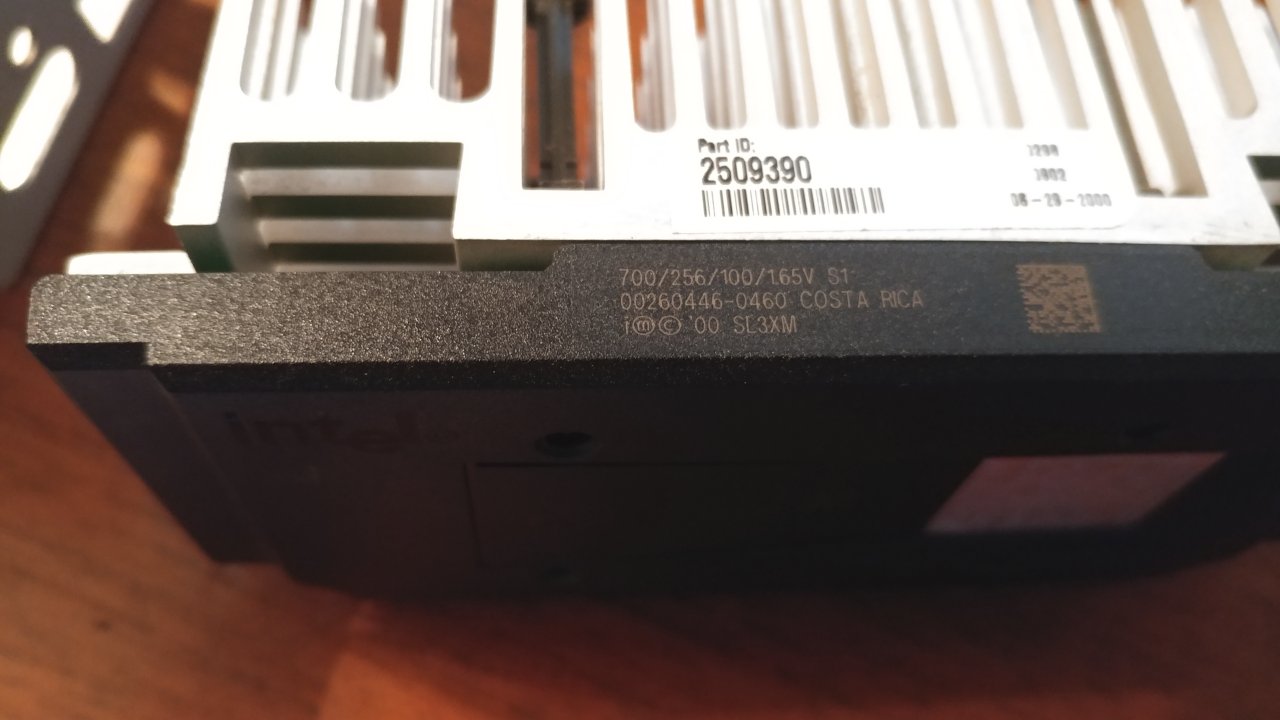
One nice surprise was finding out the details of the CPU. The listing said it was a Celeron and I couldn't find any information on a Slot 1 700 MHz Celeron, so I was quite pleased to see that it's actually a Pentium 3. (I was worried it'd be an older Celeron that lacked a L2 cache but actually looking at a list of them that very bad idea was only done with the earliest models that top out at 300 MHz.)
Can I say it's also super weird to me that a CPU can just... not have a fan?
Growing up, my first computer that was actually mine was an 800 MHz Duron so I do like that the system isn't that far off what I had as a teen. Part of me does want to see the real upper limit on what this thing can do and i imagine getting something faster may happen down the line, but I love that this thing can get away with not having a fan. I hope I don't burn down this apartment playing Unreal.

The memory led to a moment of confusion. Three sticks for three slots. The listing said 192 megs of RAM which would make each one 64 MB in size. However, when I got it booting I found out that it's actually a 128 MB stick and two 64 MB sticks. Alas, one of the sticks is detected as bad, so the listing was in fact accurate.
With the Latias laptop I spent like $10 on an extra 512 MB of memory for it. With this board, the details on how much RAM I can cram inside is a bit fuzzier. I've seen things saying the limit is 1 GB and also things saying the limit is 384 MB stating that the chipset only supports sticks up to 128 MB each and the motherboard only has 3 slots. Then also seeing people say "yeah but sometimes they say that just because they only tested it with 128 MB sticks since a 256 MB stick of RAM wasn't really a thing.
Well $20 on ebay for a pile of assorted RAM means I'll find out soon enough. It's a mix of PC100/PC133 sticks at both 128 and 256 megs so I'll wind up filling the three slots with 640 or 384 megabytes and both of those numbers are excessive for Windows 98.

Here's an ethernet card. For some reason my brain throught this was a modem. I think because I saw "BEL". I ended up leaving it out when I put everything back together because of that mistake. I doubt I'll bother putting it back in. I did get the Win2K laptop connected through my desktop and online, but there's not a lot you can do with a web browser that old on the modern web. Admittedly, watching Homestar Runner cartoons is one such thing.
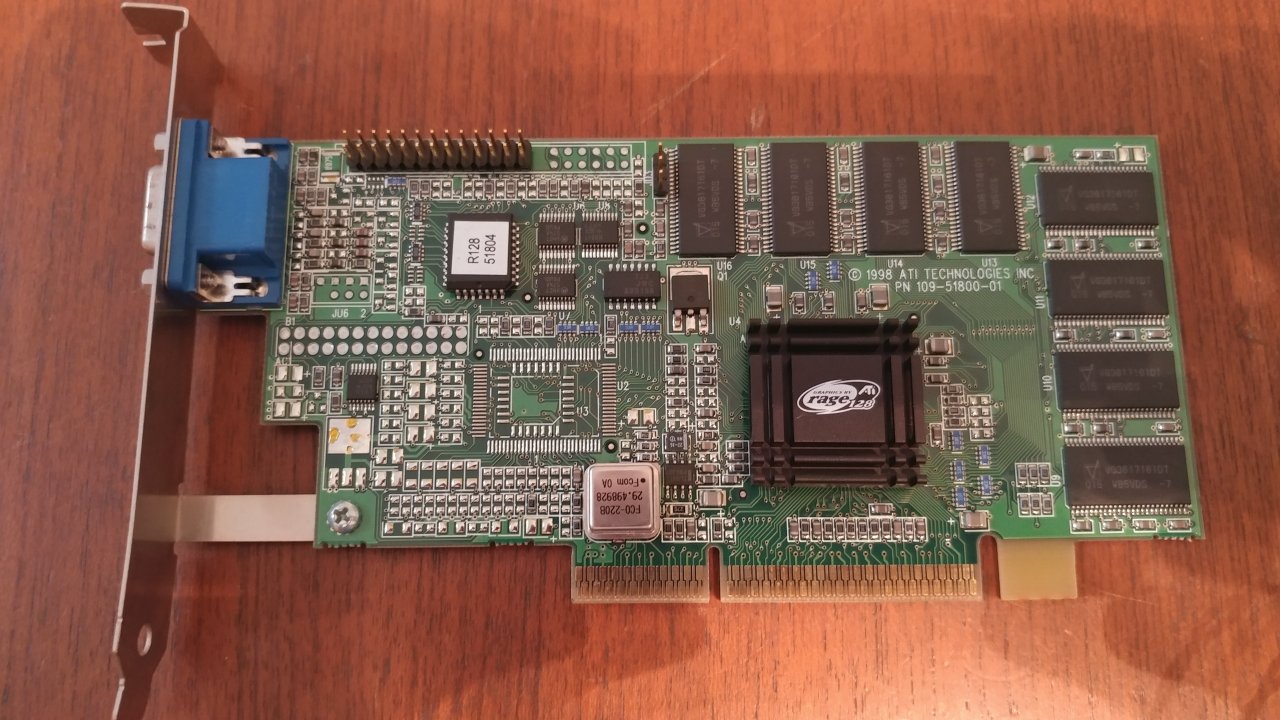
The graphics card included was a complete mystery with no information providing in the listing and no angle to even guess what it might be inside the machine. It turned out to be a Rage 128! I was hoping I'd luck out and get something a bit more modern, but for something included with the system I can't complain. I haven't found which variation it is specifically so its still a mystery really.
Still, with a card from 1998 I figured I could at least safely run Half-Life, Unreal, and Quake 2/3 better than the laptop I was using before.
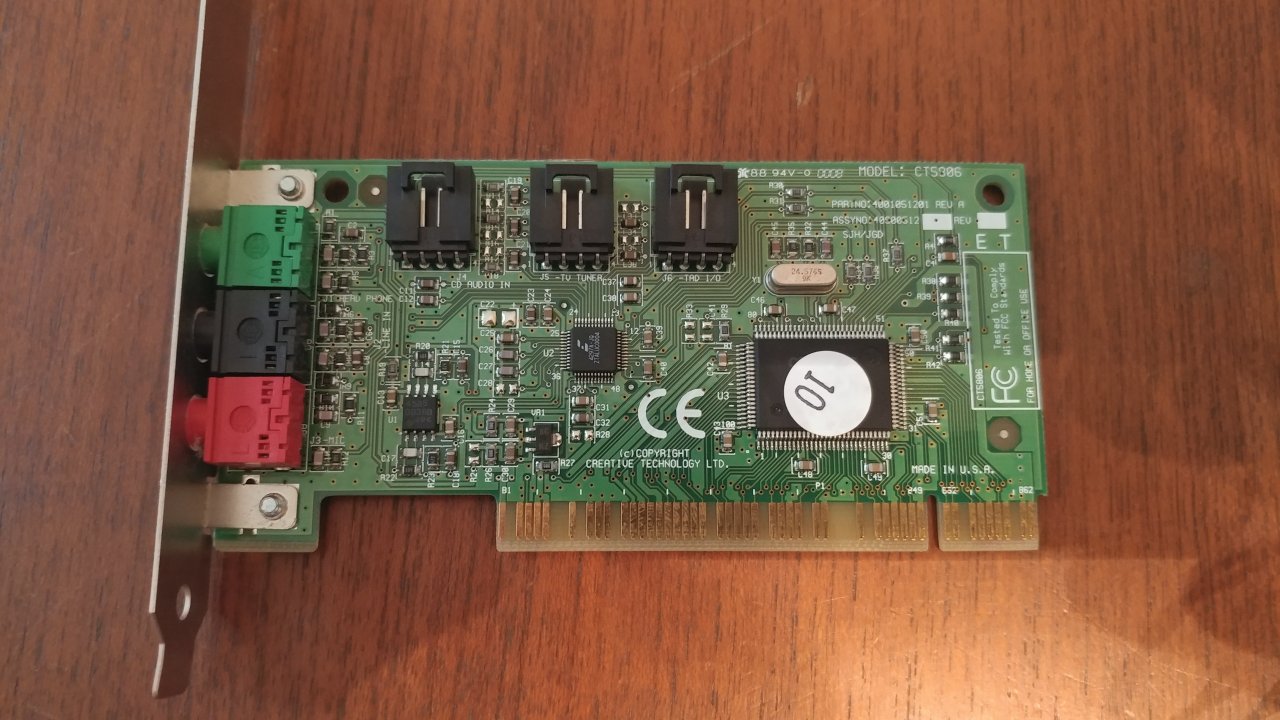
The sound card was also a mystery but one that wasn't going to have nearly as wide a range in technology. It turned out to be a Sound Blaster PCI128. I have no idea how it sounds becuase I did not find the right drivers at first.
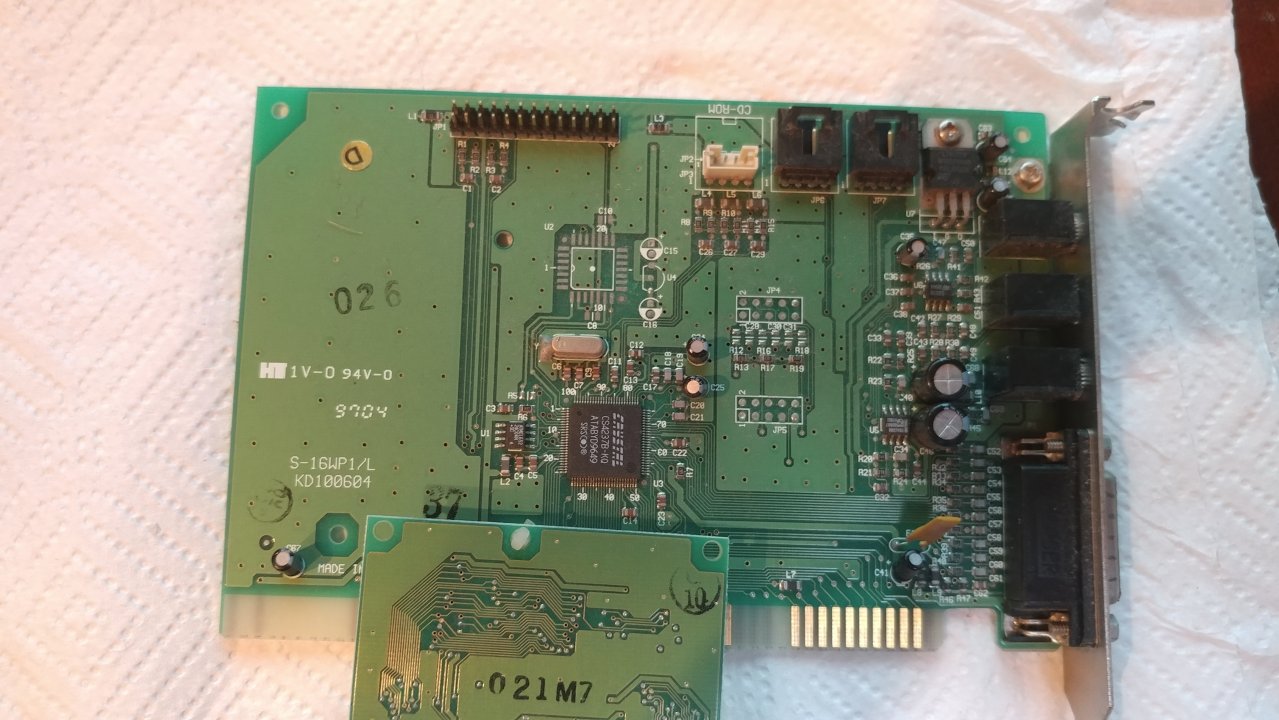
Instead, I went with this Crystal ISA sound card instead. This didn't come with the Gateway, but was salvaged from my parents' basement. It's the sound card that was included with the Packard Bell that was the family's first computer in 1995. It's pretty neat to have something from the first computer I seriously used still running today, but it won't be staying for long with how not particularly great a lot of things sound.
It does have a daughterboard that's swiveled out of the way for this photo.
Right now both cards are still inside, but I think I'm going to end up replacing both of them. Keep something in ISA for DOS compatibility and then get something a little nicer for Windows gaming.

And finally, I had to put in some kind of storage since nothing was included. It's a 30 GB drive that was included with my first computer, so right now this thing has pieces of two childhood computers in it. (I had secretly hoped the graphics card might be a TNT2 since that's what another childhood computer had inside and it could just be a mishmash of tech I grew up with.)
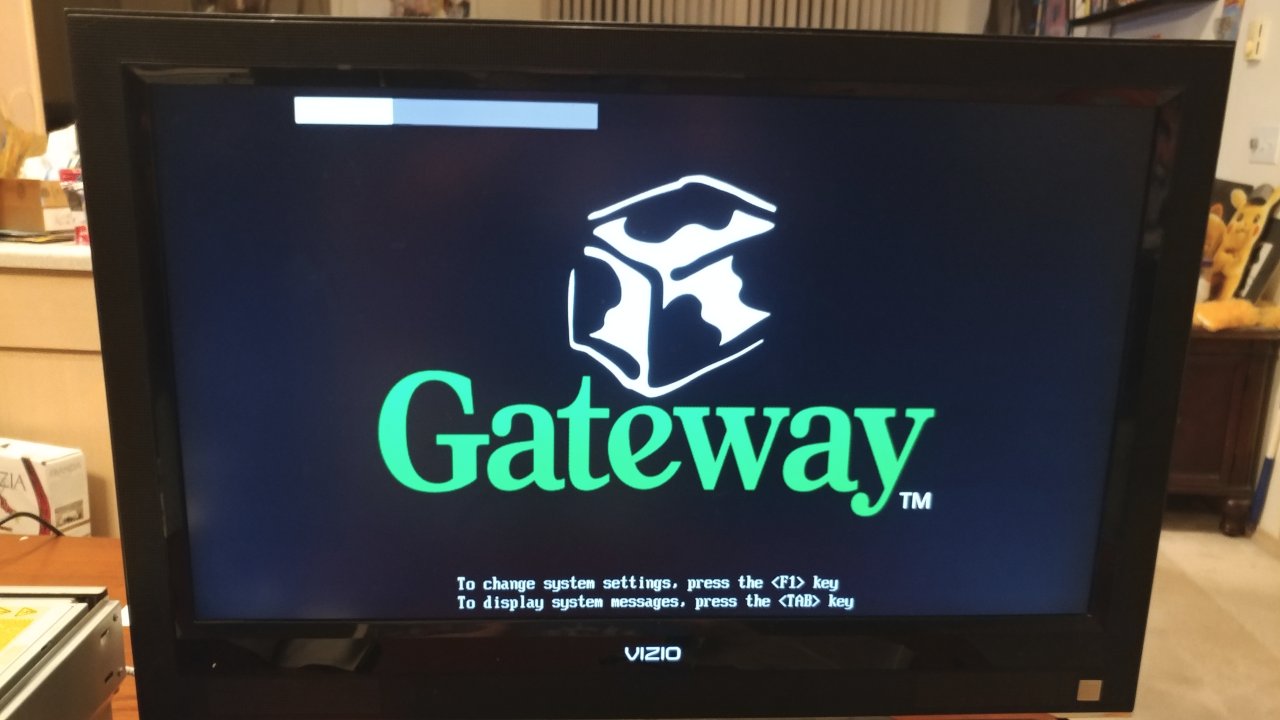
With all the parts cleaned and everything put back together it was time to see if I could get it all to work! This hit a snag immediately as the old monitor I borrowed from a roommate that he was confident still worked turned out not to. The only other display I had available was lugging out a 30" TV that used to actually be used as my main monitor and now is plugged into an old laptop for Twitch/YouTube viewing.
Once I got a functioning monitor I was greeted with this friendly Gateway logo which I love.

The BIOS revealed to me the bad RAM, but everything else looked good! The floppy, CD, and hard disk drives were all properly detected. My next issue was with using an MS-DOS 6.22 boot disk to try and format the drive. I was mistakenly under the impression that it could still format the full drive, but beyond 2 GB it wouldn't even display it as an option to format. This was solved by just using a Windows 98 SE bootdisk instead and installing from there.
Oh, I also had trouble with not having a keyboard/mouse in MS-DOS because my only ones were USB, almost calling it a night until I could get some older PS/2 devices before remembering Legacy USB was a BIOS option.
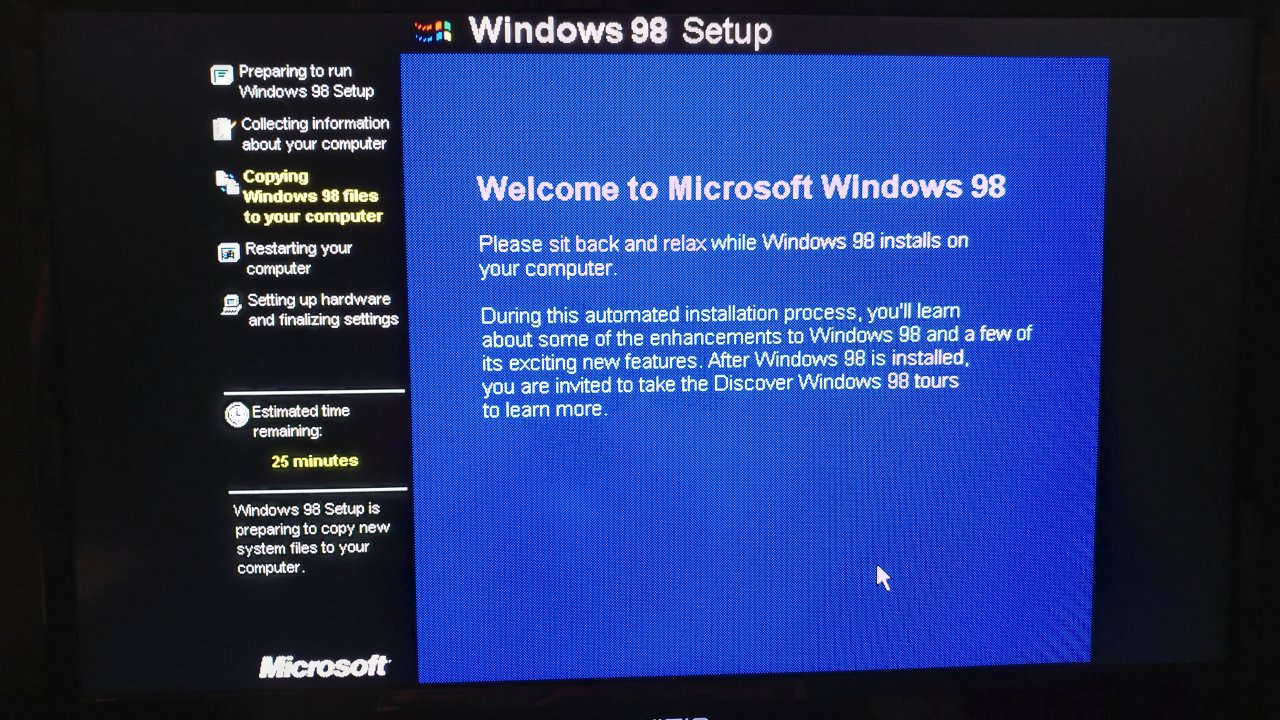
It was all coming together!

Everything installed and I had a working Windows 98 installation! The CD even had drivers for the ISA sound card that it found immediately.
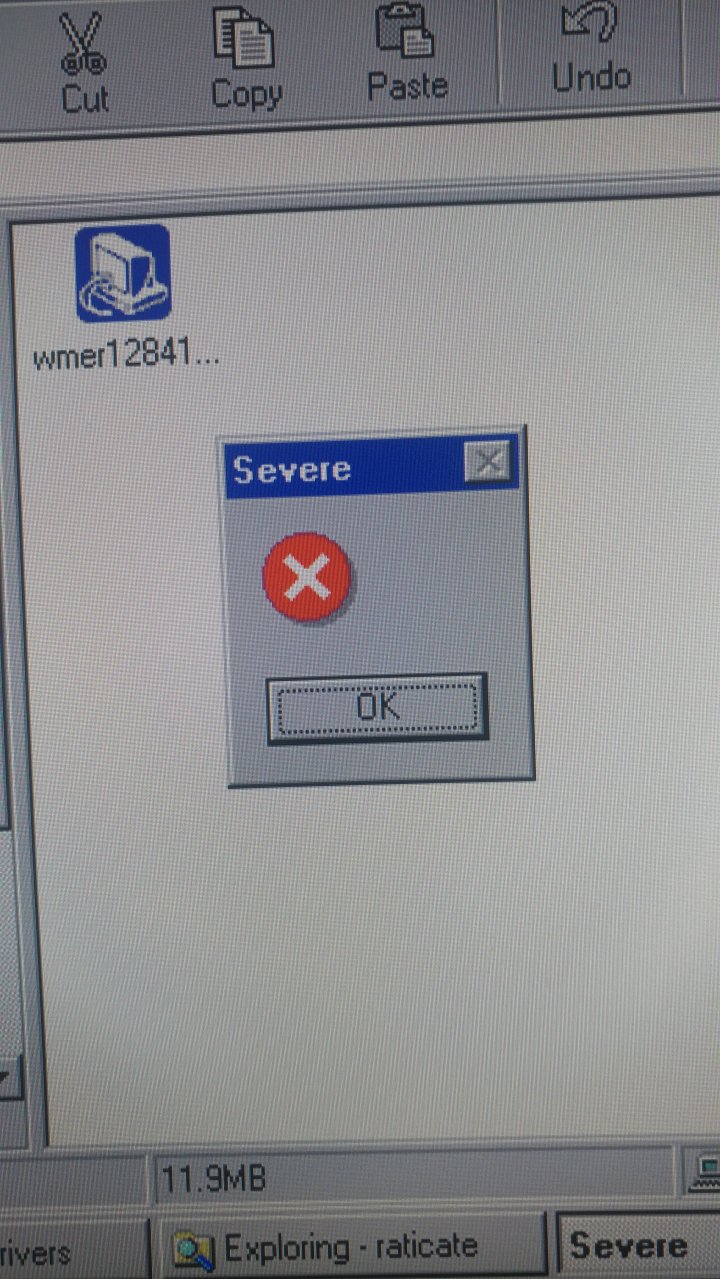
Next was the video drivers, which didn't inspire confidence as the first thing the executable displayed was this, but after the prompt was closed everything installed just fine.
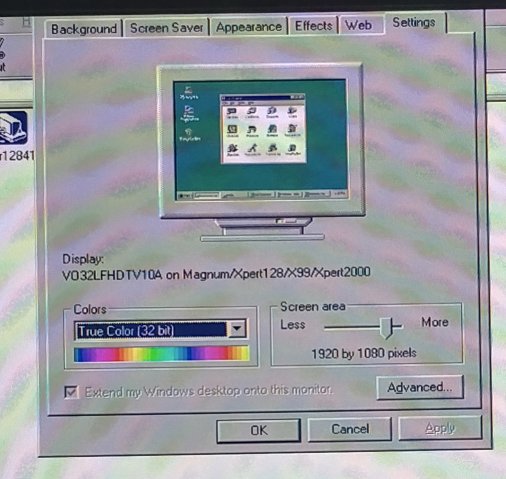
The mystery graphics card seems to simultaneously list itself as four variants of the Rage 128 which isn't very helpful. I was shocked to see that it listed 1080p as a possible resolution, but selecting it resulted in a 4:3 image that could be scrolled around. To be fair, I originally was planning to run this thing at 1024x768 so "Graphics card from 1998 can't support full HD properly" isn't much of a snag.
My next plans were to swing by the local thrift stores and pick up any old monitor and test out a bunch of games to see what it could do!
